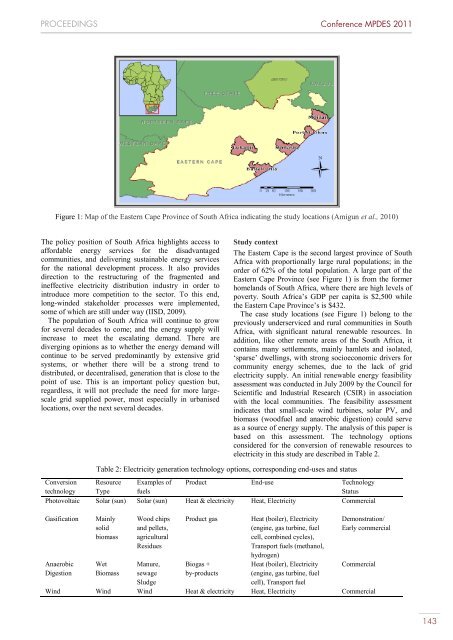Martina Schäfer, Noara Kebir, Daniel Philipp (editors) - TU Berlin
Martina Schäfer, Noara Kebir, Daniel Philipp (editors) - TU Berlin
Martina Schäfer, Noara Kebir, Daniel Philipp (editors) - TU Berlin
Create successful ePaper yourself
Turn your PDF publications into a flip-book with our unique Google optimized e-Paper software.
PROCEEDINGS Conference MPDES 2011<br />
Figure 1: Map of the Eastern Cape Province of South Africa indicating the study locations (Amigun et al., 2010)<br />
The policy position of South Africa highlights access to<br />
affordable energy services for the disadvantaged<br />
communities, and delivering sustainable energy services<br />
for the national development process. It also provides<br />
direction to the restructuring of the fragmented and<br />
ineffective electricity distribution industry in order to<br />
introduce more competition to the sector. To this end,<br />
long-winded stakeholder processes were implemented,<br />
some of which are still under way (IISD, 2009).<br />
The population of South Africa will continue to grow<br />
for several decades to come; and the energy supply will<br />
increase to meet the escalating demand. There are<br />
diverging opinions as to whether the energy demand will<br />
continue to be served predominantly by extensive grid<br />
systems, or whether there will be a strong trend to<br />
distributed, or decentralised, generation that is close to the<br />
point of use. This is an important policy question but,<br />
regardless, it will not preclude the need for more largescale<br />
grid supplied power, most especially in urbanised<br />
locations, over the next several decades.<br />
Study context<br />
The Eastern Cape is the second largest province of South<br />
Africa with proportionally large rural populations; in the<br />
order of 62% of the total population. A large part of the<br />
Eastern Cape Province (see Figure 1) is from the former<br />
homelands of South Africa, where there are high levels of<br />
poverty. South Africa’s GDP per capita is $2,500 while<br />
the Eastern Cape Province’s is $432.<br />
The case study locations (see Figure 1) belong to the<br />
previously underserviced and rural communities in South<br />
Africa, with significant natural renewable resources. In<br />
addition, like other remote areas of the South Africa, it<br />
contains many settlements, mainly hamlets and isolated,<br />
‘sparse’ dwellings, with strong socioeconomic drivers for<br />
community energy schemes, due to the lack of grid<br />
electricity supply. An initial renewable energy feasibility<br />
assessment was conducted in July 2009 by the Council for<br />
Scientific and Industrial Research (CSIR) in association<br />
with the local communities. The feasibility assessment<br />
indicates that small-scale wind turbines, solar PV, and<br />
biomass (woodfuel and anaerobic digestion) could serve<br />
as a source of energy supply. The analysis of this paper is<br />
based on this assessment. The technology options<br />
considered for the conversion of renewable resources to<br />
electricity in this study are described in Table 2.<br />
Table 2: Electricity generation technology options, corresponding end-uses and status<br />
Conversion Resource Examples of Product End-use Technology<br />
technology Type fuels<br />
Status<br />
Photovoltaic Solar (sun) Solar (sun) Heat & electricity Heat, Electricity Commercial<br />
Gasification Mainly<br />
solid<br />
biomass<br />
Anaerobic<br />
Digestion<br />
Wet<br />
Biomass<br />
Wood chips<br />
and pellets,<br />
agricultural<br />
Residues<br />
Manure,<br />
sewage<br />
Sludge<br />
Product gas Heat (boiler), Electricity<br />
(engine, gas turbine, fuel<br />
cell, combined cycles),<br />
Transport fuels (methanol,<br />
hydrogen)<br />
Biogas +<br />
by-products<br />
Heat (boiler), Electricity<br />
(engine, gas turbine, fuel<br />
cell), Transport fuel<br />
Demonstration/<br />
Early commercial<br />
Commercial<br />
Wind Wind Wind Heat & electricity Heat, Electricity Commercial<br />
143


